This article was written by Hajer Naili, the UN Migration Agency (IOM)’s Communications and Social Media Coordinator in Washington D.C and published on Medium.
—-
First it was Harvey, and then came Irma.
Both were destructive.
Images and footage coming from Texas were heartbreaking. Hurricane Harvey wreaked havoc in the Lone Star State leaving thousands of homes abandoned, covered by several inches of water. Cars were destroyed and highways immersed in floods of water. Residents fled to safety on inflatable boats or by feet, wading through knee-deep and even waist-high water.
A few days later, Irma made its landfall farther east, on the Caribbean Islands, Puerto Rico and some parts of Florida. At least, 43 people were killed in the Caribbean and at least 18 in the Southeastern U.S. In French Caribbean territory, the storm caused “major damage”, according to French Overseas Territories Minister, Annick Girardin. Even Saint Martin’s Government buildings, some of the sturdiest structures on the island, were destroyed.
In Texas, the damage caused by Hurricane Harvey was estimated between USD 150–180 billion by its Governor, Greg Abbott. Harvey was the most powerful hurricane to hit Texas in more than 50 years, killing about 50 people, displacing more than a million residents and damaging some 200,000 homes.
It might be too early to determine how many of those who have been displaced will be able to return to their homes; however Harvey and Irma are here to remind us that displacement linked to natural disasters has become one of the biggest humanitarian challenges of our century. Between 2008 and 2016, 227.6 million people were forced from their homes due to floods, earthquakes, tropical storms, and other natural hazards, according to the Internal Displacement Monitoring Center.
For several years now, IOM, the UN Migration Agency has been a first-responder to scenes devastated by natural disasters around the world and has, unfortunately, witnessed too often their disastrous and deadly effects.

Disaster-induced displacement is a global phenomenon. Currently, extreme rainfall has led to devastating floods and landslides across Nepal, India and Bangladesh killing nearly 1,200 and displacing millions. Three weeks ago as well, the West African nation of Sierra Leone was hit by floods and mudslides killing nearly 500 people, with over 600 missing and leaving about 4,000 people homeless.
Many of those who are displaced in the context of disasters might never return to their home and it’s most likely to be the case for several residents of Texas.
Already, the Lone Star State was home to about 100,000 evacuees, who had fled News Orleans during Katrina in 2005. It is still unclear how many of them have been affected and displaced again by Harvey. Globally, it is not unusual to see individuals displaced multiple times because of extreme-weather events or gradual environmental degradation such as desertification and rising sea levels.
Ironically, Texas is also home to the country’s largest refugee community. The Lone Star State has led the nation in refugee resettlements for the last five years and after the passage of Harvey, it is expected that refugees who had fled their country have been displaced again.
Twenty-one year old Ahmed Badr, who had come to the U.S. as an Iraqi refugee, was stuck at home with his family for four days in Houston.
“Our neighborhood was not affected as badly as others,” said Badr in a phone interview. “At the peak of the storm, the streets were flooded but it wasn’t as bad as for some friends who lost their entire home. We got very lucky!”
Badr and his family were not as lucky in July 2006 when a bomb ripped through their house in Baghdad, Iraq. In 2008, when approved for resettlement in the United States, the Badr family was resettled in Texas. Houston became their new home.
“Tragedy doesn’t discriminate. It affects refugees, citizens, people across all shapes, sizes and colors but seeing the resilience on people’s faces as they left their homes and came back was really incredibly powerful,” added Badr.
Badr was only seven, when he fled Iraq — too young to comprehend why his family had to leave. Now as an adult, he says, that he has become aware of the reasons that push families to leave and the implications. “I didn’t understand what exactly it meant when my house was bombed; whereas now I am more equipped to fully think it through, to think about the implications and how people are affected by a tragedy,” said Badr.
Since the early 1990s, IOM has been advocating for better understanding of the complex linkages between migration, displacement, environment and climate change.
There is increasing recognition that climate change and the environment significantly affect human mobility as confirmed in the Paris Agreement at UNFCCC COP21. Migration can be an adaptation strategy to cope with climate change where mobility becomes the sole alternative to reduce vulnerability.
Environmental migration, will continue; however, we must minimize the negative impacts on affected communities. One avenue to achieve this is through increased collaboration between environmental, humanitarian and development policy makers.
From the U.S. to Africa to South Asia and the Pacific, no country is today immune to natural hazards. All countries — developed or developing — face challenges with respect to displacement. Yet, those who are poor and marginalized often suffer disproportionately from the effects of disasters, in part because their houses have less solid construction and they are less likely to own their homes, which means they are less likely to be eligible for assistance to rebuild them. Poor and marginalized individuals might also not have the resources to leave areas exposed to hazards.
The most vulnerable groups, such as women, children and people with disabilities, tend to be the first to suffer from the chaos during and after a disaster, as reported by Vox.
Both developed and developing countries are likely to face more displacement as sudden-onset disasters — hurricanes, floods, landslides — and slow-onset disasters — drought and sea level rise — continue and will likely force more people from their homes. Developing effective policies to prevent, respond to and recover from disaster-induced displacement is vital. Countries, regardless of where they are, can learn from one another and work together to ensure solutions are found to those who are displaced.
Read more about the International Organization for Migration















